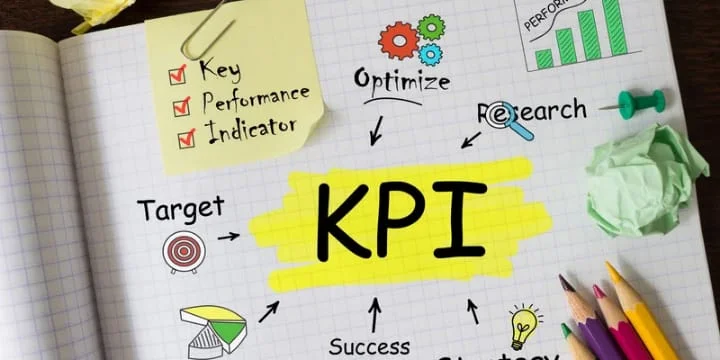In the dynamic world of business, measuring success goes beyond simply tracking revenue and profits. To truly understand and drive performance, businesses need to utilize Key Performance Indicators (KPIs). But what exactly are KPIs, and why are they essential for business success?
Key Performance Indicators are quantifiable measurements that help organizations track and assess the efficiency of their operations in achieving key objectives. They serve as a navigational tool, guiding businesses toward their strategic goals by providing insights into various aspects of performance. From financial health to customer satisfaction, KPIs offer a comprehensive view of how well a company is performing and where improvements are needed.
Understanding and implementing KPIs can seem daunting, but their importance cannot be overstated. KPIs are not just numbers; they are critical elements that inform decision-making, strategy adjustments, and overall business growth. In this blog post, we will delve into the world of KPIs, exploring their definitions, and types, and how to effectively choose and implement them in your organization.
Stay tuned as we uncover the essentials of KPIs, from understanding their significance to practical steps for implementation, ensuring your business is equipped with the tools needed to measure and drive success.
What are Key Performance Indicators?
Key Performance Indicators (KPIs) are specific, measurable values that demonstrate how effectively an organization is achieving its key business objectives. They are used by businesses to evaluate their success at reaching targets across various operational areas. KPIs can be financial, such as revenue growth and profit margins, or they can be non-financial, such as customer satisfaction and employee engagement.

Historical Context and Evolution of KPIs
The concept of performance measurement has been around for centuries, but the modern approach to KPIs originated in the 20th century. Early businesses focused primarily on financial metrics, but as industries evolved, so did the need for more comprehensive performance measures. The balanced scorecard, developed in the 1990s by Robert Kaplan and David Norton, revolutionized performance measurement by introducing KPIs that looked beyond financial performance to include customer, internal process, and learning and growth perspectives.
Why KPIs Matter
KPIs serve as a bridge between strategy and execution. They translate abstract goals into concrete metrics, allowing businesses to track progress and make data-driven decisions. By monitoring KPIs, organizations can identify trends, uncover issues, and implement changes proactively. Effective KPIs provide a clear picture of current performance and highlight areas for improvement, enabling businesses to align their operations with strategic objectives.
Examples of KPIs
To better understand KPIs, consider the following examples:
- Financial KPIs: Net profit margin, revenue growth rate, return on investment (ROI)
- Operational KPIs: Average production time, order fulfilment rate, inventory turnover
- Sales and Marketing KPIs: Conversion rate, customer acquisition cost (CAC), lifetime value (LTV)
- Customer KPIs: Customer satisfaction score (CSAT), Net Promoter Score (NPS), customer retention rate
- HR KPIs: Employee turnover rate, time to hire, employee engagement score
Each KPI serves a unique purpose and provides insights into different facets of the business, collectively contributing to a comprehensive performance overview.
Importance of KPIs in Business

How KPIs Drive Business Performance
KPIs are instrumental in steering a company towards its strategic goals. By setting and monitoring KPIs, businesses can ensure that every aspect of their operations aligns with their overall objectives. KPIs provide a framework for measuring success, enabling organizations to focus on what matters most. Here are several ways KPIs drive business performance:
- Strategic Alignment: KPIs ensure that all departments and teams work towards common goals. They translate broad business objectives into specific, actionable metrics, fostering a unified direction across the organization.
- Informed Decision-Making: With clear, quantifiable data, managers and executives can make informed decisions. KPIs highlight areas of success and pinpoint where improvements are needed, reducing guesswork and enhancing strategic planning.
- Performance Monitoring: Continuous tracking of KPIs allows businesses to monitor progress over time. This helps in identifying trends, spotting potential issues early, and adjusting strategies promptly to stay on course.
- Employee Engagement: When employees understand how their work contributes to the overall business goals, they are more likely to be engaged and motivated. KPIs provide clear targets and a sense of purpose, driving higher performance and job satisfaction.
Examples of Successful KPI Implementation
Several companies have successfully leveraged KPIs to drive performance and achieve their goals. For instance:
- Amazon: By focusing on customer-centric KPIs such as delivery times, order accuracy, and customer satisfaction scores, Amazon has become a leader in the e-commerce industry. Their relentless focus on these metrics ensures a consistently high level of customer service.
- Google: Google uses KPIs to track and improve various aspects of its operations, from search engine performance to employee engagement. One notable KPI is the “OKR” (Objectives and Key Results), a framework that helps Google set and achieve ambitious goals.
- Tesla: Tesla employs KPIs to monitor production efficiency, quality control, and innovation. By keeping a close eye on these metrics, Tesla continues to push the boundaries of automotive technology and maintain its competitive edge.
These examples illustrate how KPIs, when chosen and implemented effectively, can lead to significant business improvements and sustained success.
Types of KPIs
Understanding the different types of KPIs is essential for selecting the right metrics that align with your business objectives. KPIs can be broadly categorized into several groups based on their focus areas:

1. Financial KPIs
Financial KPIs measure the monetary aspects of a business, providing insights into profitability, liquidity, and financial stability. Common financial KPIs include:
- Net Profit Margin: The percentage of revenue that remains as profit after all expenses are deducted.
- Revenue Growth Rate: The increase in a company’s sales over a specific period.
- Return on Investment (ROI): The ratio of net profit to the total investment, indicating the efficiency of investments.
2. Operational KPIs
Operational KPIs track the efficiency and performance of various business processes. These KPIs help identify bottlenecks and areas for improvement. Examples include:
- Average Production Time: The average time taken to produce a unit of product.
- Order Fulfillment Rate: The percentage of customer orders that are completed on time.
- Inventory Turnover: The rate at which inventory is sold and replaced over a period.
3. Sales and Marketing KPIs
These KPIs assess the effectiveness of sales and marketing strategies, focusing on customer acquisition, conversion, and retention. Key metrics include:
- Conversion Rate: The percentage of visitors who take a desired action, such as making a purchase.
- Customer Acquisition Cost (CAC): The total cost of acquiring a new customer, including marketing and sales expenses.
- Customer Lifetime Value (LTV): The total revenue expected from a customer over the duration of their relationship with the company.
4. Customer KPIs
Customer KPIs measure customer satisfaction and loyalty, critical for maintaining a strong customer base. Important customer KPIs are:
- Customer Satisfaction Score (CSAT): A measure of customer satisfaction with a product or service.
- Net Promoter Score (NPS): The likelihood that customers will recommend your business to others.
- Customer Retention Rate: The percentage of customers who continue to do business with you over a period.
5. HR KPIs
HR KPIs evaluate the effectiveness of human resource management, focusing on employee performance, satisfaction, and retention. Examples include:
- Employee Turnover Rate: The percentage of employees who leave the company over a period.
- Time to Hire: The average time taken to fill a vacant position.
- Employee Engagement Score: A measure of how engaged and motivated employees are in their work.
Each type of KPI serves a specific purpose and provides unique insights into different facets of the business. By tracking a balanced mix of these KPIs, organizations can gain a holistic view of their performance and make informed decisions to drive growth and success.
How to Choose the Right KPIs
Choosing the right Key Performance Indicators (KPIs) is crucial for accurately measuring performance and achieving your business goals. Here’s a guide to help you select the most relevant KPIs for your organization:

1. Align KPIs with Business Goals
Your KPIs should directly relate to your strategic objectives. Start by identifying your business goals, then determine which metrics will help you measure progress towards those goals. For example:
- Goal: Increase market share
- Relevant KPIs: Market penetration rate, customer acquisition cost, conversion rate
2. Use the SMART Criteria
To ensure your KPIs are effective, apply the SMART criteria:
- Specific: KPIs should be clear and specific, leaving no room for ambiguity.
- Measurable: You should be able to quantify and measure the KPI accurately.
- Achievable: KPIs should be realistic and attainable, given your resources and constraints.
- Relevant: Ensure the KPI is relevant to your business objectives and priorities.
- Time-bound: KPIs should have a specific timeframe for evaluation.
3. Focus on Key Areas
Concentrate on KPIs that impact critical areas of your business. Avoid the temptation to track too many metrics, which can lead to analysis paralysis. Focus on a few key areas, such as:
- Financial Performance: Net profit margin, revenue growth rate
- Customer Satisfaction: Net Promoter Score (NPS), customer retention rate
- Operational Efficiency: Average production time, order fulfillment rate
- Employee Performance: Employee turnover rate, time to hire
4. Avoid Common Pitfalls
When choosing KPIs, be mindful of common pitfalls that can undermine their effectiveness:
- Vanity Metrics: Avoid metrics that look good on paper but don’t provide actionable insights (e.g., number of social media followers).
- Irrelevant KPIs: Ensure the KPIs you select are directly tied to your strategic objectives.
- Overcomplicating KPIs: Keep your KPIs simple and easy to understand.
5. Revisit and Revise KPIs Regularly
KPIs should not be set in stone. Regularly review and adjust them to reflect changes in your business environment, strategy, and goals. This ensures your KPIs remain relevant and effective.
Example of Aligning KPIs with Business Goals:
- Objective: Improve customer satisfaction
- Relevant KPI: Customer Satisfaction Score (CSAT)
- Reason: Directly measures how satisfied customers are with your products or services
- Objective: Increase operational efficiency
- Relevant KPI: Average production time
- Reason: Helps identify areas where processes can be streamlined to save time and reduce costs
Choosing the right KPIs is a dynamic process that requires careful consideration and ongoing evaluation. By aligning KPIs with your business goals, applying the SMART criteria, focusing on key areas, avoiding common pitfalls, and regularly revisiting your KPIs, you can create a robust framework for measuring and driving business performance.
Implementing KPIs in Your Organization
Implementing KPIs effectively requires a strategic approach and the right tools. Here’s a step-by-step guide to help you integrate KPIs into your organization:

1. Define Clear Objectives
Start by clearly defining the objectives you want to achieve with your KPIs. Make sure these objectives align with your overall business goals. This clarity will guide the selection and implementation of the appropriate KPIs.
2. Identify Relevant KPIs
Based on your objectives, identify the KPIs that will help you measure progress. Ensure these KPIs are specific, measurable, achievable, relevant, and time-bound (SMART). Involve key stakeholders in this process to ensure buy-in and relevance across the organization.
3. Communicate KPIs Across the Organization
Effective communication is crucial for successful KPI implementation. Ensure all employees understand the chosen KPIs, their significance, and how they relate to their roles. Use clear and concise language to explain the KPIs and provide examples of how they can be used.
4. Set Up Tracking and Reporting Systems
To monitor KPIs effectively, set up tracking and reporting systems. Use tools and software that can automatically collect and analyze data, such as:
- Dashboard Software: Tools like Tableau, Power BI, and Google Data Studio can help visualize KPIs in real-time.
- CRM Systems: Platforms like Salesforce can track customer-related KPIs.
- Project Management Tools: Applications like Asana or Trello can monitor operational KPIs.
Ensure these systems are accessible to all relevant stakeholders and provide regular updates on KPI performance.
5. Establish Baselines and Targets
Before you can measure progress, establish baseline metrics for your KPIs. These baselines serve as a starting point to compare future performance. Then, set realistic targets for each KPI based on your business objectives and past performance.
6. Monitor and Analyze KPI Data
Regularly monitor KPI data to track progress towards your targets. Use your tracking systems to analyze the data and generate reports. Look for trends, patterns, and any deviations from expected performance.
7. Take Action Based on Insights
The ultimate goal of tracking KPIs is to drive improvement. Use the insights gained from your KPI data to make informed decisions and take action. This might involve adjusting strategies, reallocating resources, or addressing specific issues.
8. Review and Adjust KPIs Regularly
KPIs should be dynamic and adaptable to changes in your business environment. Regularly review your KPIs to ensure they remain relevant and aligned with your business goals. Adjust them as needed to reflect new priorities, market conditions, or strategic shifts.
Best Practices for KPI Implementation:
- Involve Stakeholders: Engage employees and other stakeholders in the KPI selection and implementation process to ensure buy-in and relevance.
- Simplify Reporting: Use clear and straightforward reporting formats to make KPI data easily understandable.
- Encourage Accountability: Assign ownership of each KPI to specific individuals or teams to promote accountability and action.
- Provide Training: Offer training sessions to help employees understand how to use KPIs effectively and interpret the data.
Example of Implementing KPIs:
A retail company aiming to improve customer satisfaction might implement the following steps:
- Objective: Enhance customer satisfaction
- KPI: Customer Satisfaction Score (CSAT)
- Communication: Explain the importance of CSAT to all employees and how it impacts the business.
- Tracking: Use a CRM system to collect customer feedback and calculate CSAT.
- Baselines and Targets: Establish a baseline CSAT of 70% and set a target of 85% within six months.
- Monitor: Regularly review CSAT data and identify areas needing improvement.
- Action: Implement training programs for customer service staff and make process adjustments based on feedback.
- Review: After six months, assess the CSAT progress and adjust the strategy if necessary.
Implementing KPIs effectively requires a structured approach, clear communication, and ongoing evaluation. By following these steps and best practices, organizations can ensure their KPIs drive meaningful improvements and help achieve strategic goals.
Measuring and Analyzing KPIs
Measuring and analyzing Key Performance Indicators (KPIs) is crucial for understanding your business’s performance and making informed decisions. Here’s how to effectively measure and analyze KPIs:

1. Collect Accurate Data
The accuracy of your KPI analysis depends on the quality of your data. Ensure you have reliable systems in place to collect data consistently. This might include:
- Automated Data Collection: Use software and tools that can automatically gather data, reducing the risk of human error.
- Regular Audits: Periodically audit your data collection processes to ensure accuracy and consistency.
- Data Sources: Verify that the data sources are reliable and relevant to the KPIs being measured.
2. Establish Benchmarks
Before you can measure progress, you need to establish benchmarks or baseline metrics. These benchmarks serve as reference points to compare your current performance. Benchmarks can be based on:
- Historical Data: Past performance data from your organization.
- Industry Standards: Average performance metrics within your industry.
- Competitor Analysis: Performance data from similar organizations.
3. Analyze KPI Data
Analyzing KPI data involves looking for trends, patterns, and insights that can inform decision-making. Here are some key steps:
- Identify Trends: Look for upward or downward trends in your KPIs over time. This can help you understand whether performance is improving or declining.
- Compare Periods: Compare KPI data across different periods (e.g., monthly, quarterly, yearly) to identify seasonal patterns or long-term trends.
- Segment Data: Break down KPI data by different segments (e.g., by department, product line, customer demographics) to gain deeper insights.
4. Use Data Visualization
Visualizing KPI data makes it easier to understand and communicate insights. Use charts, graphs, and dashboards to present your KPI data in a clear and concise manner. Tools like Tableau, Power BI, and Google Data Studio can help create effective visualizations.
5. Interpret Insights
Interpret the data to understand the underlying factors driving the trends. Consider the following:
- Contextual Factors: External factors (e.g., market conditions, economic changes) that might impact your KPIs.
- Internal Factors: Internal processes, strategies, and initiatives that could influence performance.
- Correlation and Causation: Identify correlations between different KPIs and determine causation where possible.
6. Take Action Based on Analysis
The ultimate goal of measuring and analyzing KPIs is to drive improvement. Use the insights gained from your analysis to make informed decisions and take corrective actions. This might include:
- Strategy Adjustments: Modify strategies based on KPI performance to better align with business goals.
- Resource Allocation: Reallocate resources to areas that need improvement or are performing well.
- Process Improvements: Implement changes to processes and operations based on the analysis.
7. Review and Refine KPIs Regularly
Regularly reviewing and refining your KPIs ensures they remain relevant and effective. As your business evolves, your KPIs may need to be adjusted to reflect new priorities and goals.
Example of Measuring and Analyzing KPIs:
A marketing team tracking their campaign performance might follow these steps:
- Collect Data: Use marketing automation tools to collect data on campaign metrics such as click-through rates (CTR), conversion rates, and cost per acquisition (CPA).
- Establish Benchmarks: Use historical data from previous campaigns to set benchmarks for each metric.
- Analyze Data: Look for trends in campaign performance over different periods and across different channels.
- Visualize Data: Create a dashboard that shows the performance of each campaign in real-time.
- Interpret Insights: Determine which campaigns are performing well and identify factors contributing to their success. Analyze underperforming campaigns to understand the issues.
- Take Action: Adjust marketing strategies, reallocate budget to high-performing campaigns, and optimize underperforming ones.
- Review and Refine: Regularly review campaign performance and refine KPIs as needed to ensure they align with marketing goals.
By following these steps, organizations can effectively measure and analyze KPIs, driving continuous improvement and achieving strategic objectives.
Conclusion
Key Performance Indicators (KPIs) are more than just numbers on a dashboard; they are vital tools that guide businesses towards their strategic goals. By understanding what KPIs are and how to effectively choose, implement, measure, and analyze them, organizations can gain valuable insights into their performance and make data-driven decisions that drive success.
From financial metrics that gauge profitability to customer KPIs that measure satisfaction, each type of KPI provides unique insights that collectively contribute to a comprehensive view of business health. Implementing the right KPIs requires a strategic approach, clear communication, and the use of reliable tools for tracking and analysis. Regularly reviewing and refining KPIs ensures they remain relevant and aligned with evolving business objectives.
In today’s competitive business environment, the ability to measure and improve performance through KPIs can make the difference between success and stagnation. By leveraging KPIs effectively, businesses can not only track their progress but also anticipate challenges and seize opportunities, ensuring long-term growth and sustainability.
By understanding and leveraging KPIs, businesses can drive performance, make informed decisions, and achieve sustainable growth. Embrace the power of KPIs to unlock your organization’s full potential and navigate the path to success.
FAQs
What is the difference between a KPI and a metric?
Answer: A KPI is a specific type of performance metric that is directly tied to business objectives and goals. While all KPIs are metrics, not all metrics are KPIs. KPIs are carefully chosen to reflect the critical success factors of an organization.
How often should KPIs be reviewed?
Answer: The frequency of KPI reviews depends on the nature of the KPI and the business context. However, it is generally recommended to review KPIs at least quarterly. For some operational KPIs, more frequent reviews, such as monthly or even weekly, may be necessary.
Can KPIs change over time?
Answer: Yes, KPIs can and should change over time as business goals and strategies evolve. Regularly reviewing and adjusting KPIs ensures they remain aligned with current objectives and market conditions.
What are some common pitfalls to avoid when implementing KPIs?
Answer: Common pitfalls include choosing too many KPIs, focusing on vanity metrics that don’t provide actionable insights, not aligning KPIs with business goals, and failing to communicate the importance and relevance of KPIs to all stakeholders.
How can I ensure my team understands and uses KPIs effectively?
Answer: Effective communication and training are crucial. Make sure your team understands what each KPI measures, why it’s important, and how it impacts their work. Use clear language and provide regular updates on KPI performance.
What tools can help with KPI tracking and analysis?
Answer: Tools such as Tableau, Power BI, Google Data Studio, Salesforce, and various project management software like Asana and Trello can help with tracking and visualizing KPI data.
What tools can help with KPI tracking and analysis?
Answer: Tools such as Tableau, Power BI, Google Data Studio, Salesforce, and various project management software like Asana and Trello can help with tracking and visualizing KPI data.
What tools can help with KPI tracking and analysis?
Answer: Tools such as Tableau, Power BI, Google Data Studio, Salesforce, and various project management software like Asana and Trello can help with tracking and visualizing KPI data.
How do KPIs relate to overall business strategy?
Answer: KPIs are directly tied to business strategy, serving as measurable benchmarks that track progress towards strategic goals. They help ensure that all parts of the organization are aligned and working towards common objectives.














